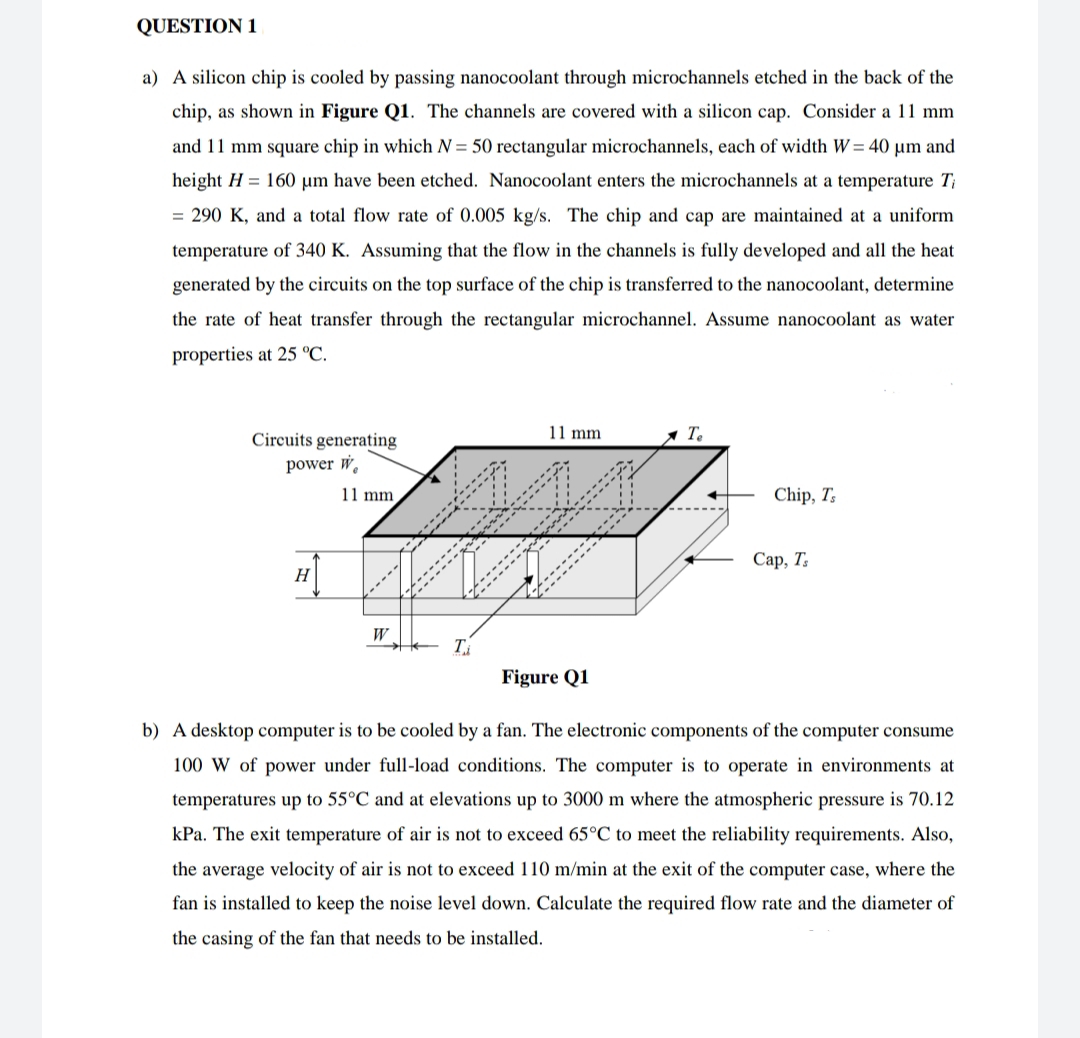QUESTION 1 a) A silicon chip is cooled by passing nanocoolant through microchannels etched in the back of the chip, as shown in Figure Q1. The channels are covered with a silicon cap. Consider a 11 mm and 11 mm square chip in which N = 50 rectangular microchannels, each of width W= 40 µm and height H = 160 µm have been etched. Nanocoolant enters the microchannels at a temperature T; = 290 K, and a total flow rate of 0.005 kg/s. The chip and cap are maintained at a uniform temperature of 340 K. Assuming that the flow in the channels is fully developed and all the heat generated by the circuits on the top surface of the chip is transferred to the nanocoolant, determine the rate of heat transfer through the rectangular microchannel. Assume nanocoolant as water properties at 25 °C.
QUESTION 1 a) A silicon chip is cooled by passing nanocoolant through microchannels etched in the back of the chip, as shown in Figure Q1. The channels are covered with a silicon cap. Consider a 11 mm and 11 mm square chip in which N = 50 rectangular microchannels, each of width W= 40 µm and height H = 160 µm have been etched. Nanocoolant enters the microchannels at a temperature T; = 290 K, and a total flow rate of 0.005 kg/s. The chip and cap are maintained at a uniform temperature of 340 K. Assuming that the flow in the channels is fully developed and all the heat generated by the circuits on the top surface of the chip is transferred to the nanocoolant, determine the rate of heat transfer through the rectangular microchannel. Assume nanocoolant as water properties at 25 °C.
Principles of Heat Transfer (Activate Learning with these NEW titles from Engineering!)
8th Edition
ISBN:9781305387102
Author:Kreith, Frank; Manglik, Raj M.
Publisher:Kreith, Frank; Manglik, Raj M.
Chapter8: Natural Convection
Section: Chapter Questions
Problem 8.48P
Related questions
Question

Transcribed Image Text:QUESTION 1
a) A silicon chip is cooled by passing nanocoolant through microchannels etched in the back of the
chip, as shown in Figure Q1. The channels are covered with a silicon cap. Consider a 11 mm
and 11 mm square chip in which N = 50 rectangular microchannels, each of width W = 40 µm and
height H = 160 µm have been etched. Nanocoolant enters the microchannels at a temperature T;
= 290 K, and a total flow rate of 0.005 kg/s. The chip and cap are maintained at a uniform
temperature of 340 K. Assuming that the flow in the channels is fully developed and all the heat
generated by the circuits on the top surface of the chip is transferred to the nanocoolant, determine
the rate of heat transfer through the rectangular microchannel. Assume nanocoolant as water
properties at 25 °C.
11 mm
1 T.
Circuits generating
power W.
11 mm
Chip, T;
Сар, Т,
H
W
Figure Q1
b) A desktop computer is to be cooled by a fan. The electronic components of the computer consume
100 W of power under full-load conditions. The computer is to operate in environments at
temperatures up to 55°C and at elevations up to 3000 m where the atmospheric pressure is 70.12
kPa. The exit temperature of air is not to exceed 65°C to meet the reliability requirements. Also,
the average velocity of air is not to exceed 110 m/min at the exit of the computer case, where the
fan is installed to keep the noise level down. Calculate the required flow rate and the diameter of
the casing of the fan that needs to be installed.
Expert Solution
This question has been solved!
Explore an expertly crafted, step-by-step solution for a thorough understanding of key concepts.
This is a popular solution!
Trending now
This is a popular solution!
Step by step
Solved in 2 steps with 2 images

Knowledge Booster
Learn more about
Need a deep-dive on the concept behind this application? Look no further. Learn more about this topic, mechanical-engineering and related others by exploring similar questions and additional content below.Recommended textbooks for you

Principles of Heat Transfer (Activate Learning wi…
Mechanical Engineering
ISBN:
9781305387102
Author:
Kreith, Frank; Manglik, Raj M.
Publisher:
Cengage Learning

Principles of Heat Transfer (Activate Learning wi…
Mechanical Engineering
ISBN:
9781305387102
Author:
Kreith, Frank; Manglik, Raj M.
Publisher:
Cengage Learning